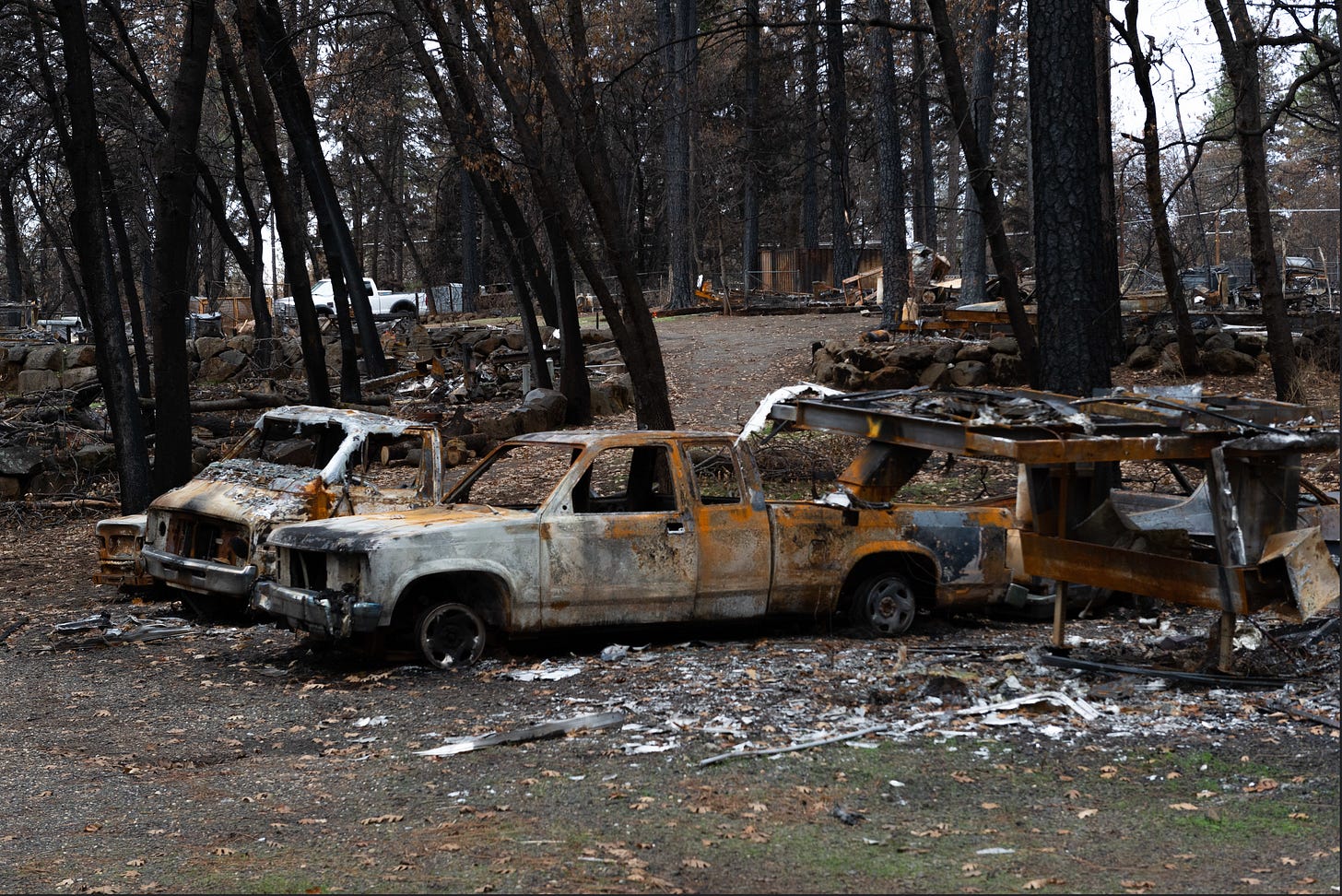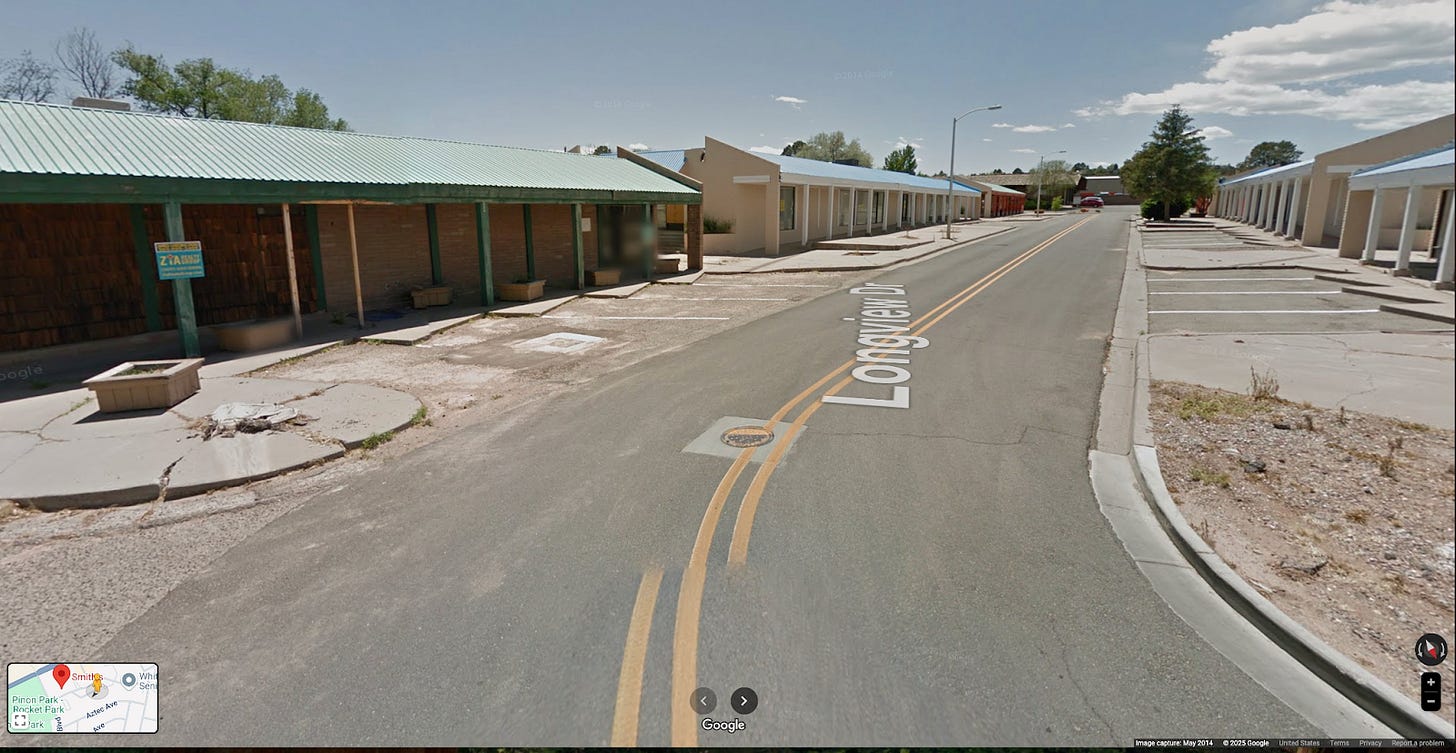As Los Alamos marks the 25th anniversary of the Cerro Grande fire this month, many of us have memories of those deeply unpleasant days in May 2000. My parents in White Rock were forced to evacuate the home where I grew up, temporarily living with us in Santa Fe while their cat reluctantly took up residence in our garage to avoid setting off allergies—a minor inconvenience compared to friends who lost everything.
From our home in Santa Fe, I remember watching that massive plume of smoke rise over the Jemez Mountains, feeling a growing sense of dread as it expanded against the New Mexico sky.
What began as a prescribed burn gone wrong ultimately transformed Los Alamos’ understanding of wildfire risk forever. In an interview with KRQE marking the 25th anniversary of the fire, former Governor Gary Johnson said firefighters from surrounding communities arrived right when officials warned him that 3,000 homes might burn that night. “I still get emotional thinking about it,” he told the news station. Those firefighters worked through the night to save countless structures.
The past informs the present
Former Fire Chief Doug McDonald (aka “Chief Mac”), who led Los Alamos County’s fire department during the Cerro Grande fire, recorded a video message this week to remind Los Alamos County Council that the town “is never out of the woods” when it comes to wildfire threats. “Cerro Grande can happen to us again,” he said. When he recorded the message, fire conditions—extreme drought index, high fuel loads, and high fire danger—mirrored those preceding Cerro Grande. (Luckily, we got drenched in the days since then, buying us some relief and time.)
But with that terrible fire came the ironic silver lining of some further wildfire protection. As author Tom Ribe said in an interview with KRQE, when the Las Conchas Fire erupted in 2011, the Cerro Grande burn scar stopped one head of the fire that was moving directly toward Los Alamos. Without that previously burned area acting as a natural firebreak, Las Conchas “would have been a much more intense, much more disastrous fire than Cerro Grande was,” Ribe said.
This relationship between wildfires and community recovery connects directly to important new research on how catastrophic fires reshape housing markets far beyond the burn zone.
Wildfires, displacement, and housing prices
A timely study published in the Journal of Housing Economics by researchers Hannah Hennighausen and Alexander James examines the aftermath of the 2018 Camp Fire in Paradise, California—a disaster with several parallels to what Los Alamos experienced (only, of course, much worse). The Camp Fire, ignited by electrical transmission lines, spread rapidly due to unusually dry vegetation and high winds, destroying roughly 11,000 homes and displacing approximately 50,000 people.
The analysis showed that homes within 25 miles of the fire’s footprint experienced a sudden 13% spike in price in the six weeks following the fire: Losing homes means losing badly needed housing stock, which increases housing pressure. Which increases price. This translated to a premium of almost $40,000 for homes in the vicinity. Effects decreased with distance but remained detectable up to 100 miles away.
In this discussion of her paper (which I strongly recommend people listen to), Hennighausen described the “stickiness” phenomenon: When tracking where displaced residents relocated, she said that “the vast, vast majority of people wanted to... stay close to where they used to live.” People do not like to be uprooted. Their lives remain anchored to their communities through jobs, schools, and social networks. This finding has big implications for climate adaptation efforts in Los Alamos. How readily will people relocate from increasingly risky areas, even after experiencing disaster firsthand? Even after insurance companies stop insuring homes?
Applying these lessons to Los Alamos
Los Alamos now faces challenges that echo Paradise’s experience, particularly regarding insurance availability. Many Los Alamos homeowners have reported being turned down by insurer after insurer, each refusing to cover their homes due to wildfire danger—even when some homeowners have taken the right “home hardening” steps. Danielle Duran, intergovernmental affairs manager for Los Alamos County, testified to the Legislature this year that despite living in a burn scar that should theoretically reduce risk, dozens of community members still lost their insurance coverage.
If homeowners cannot find an insurance company willing to cover them, or if premiums become too expensive, they have to move. Mortgage lenders require homeowners to have insurance. If enough people face this problem, it could be an existential threat for a town that has been designated as being entirely in the wildland-urban interface (WUI).
Wildfire risk as a regional housing issue
The displacement effect identified after the Camp Fire shows up in specific ways in our region, even without a wildfire. While Los Alamos has its particular demographic workforce tied to Los Alamos National Laboratory, housing scarcity has already forced adaptation patterns that play into our regional housing crisis. Our county’s failure to meaningfully increase housing stock over decades, combined with the Lab’s hiring spree, has led to nearly 10,000 people—almost 70% of the workforce—commuting from surrounding communities.
As well-paid Lab employees and contractors settle in outlying communities, housing prices rise accordingly, displacing families who have called Northern New Mexico home for countless generations. Daniel Werwath, a regional housing expert, said that Santa Fe County alone has seen about 11,000 people displaced as higher-income workers outbid long-time residents for limited housing across the entire region. (Go to about 8 minutes into that video for the context behind that number.)
These commuting patterns not only create regional housing pressures but also contribute to climate change through increased emissions, creating a vicious cycle that worsens wildfire conditions over time.
Rethinking housing and fire resilience
Like most fire-prone communities, Los Alamos faces challenges in balancing housing needs with wildfire preparedness. For years, LANL has urged the town to build more housing to shelter its workforce; successive county councils have responded by petitioning the Department of Energy to transfer more land for single-family homes—the general attitude is, “you created the problem, you fix it.” DOE has parried by pointing out that land transfers are not viable due to contamination, proximity to testing sites, or archaeological protections.
This standoff has created a policy impasse while housing costs skyrocket. While there are no easy or perfect answers, evidence increasingly points toward density as a solution. The preferred housing fix that previous councils (and council candidates) have leaned on—land transfers—seems increasingly unworkable. Housing—consisting principally of single-family homes—that creeps ever deeper into the WUI at this point will probably be uninsurable. Urban planning experts and researchers like Hennighausen say that denser internal development offers greater protection from wildfires compared to sprawling development at the interface edges.
“As a bit of a self-proclaimed urbanist, I love dense housing in safe areas,” said Hennighausen. “And then we can keep the wildfire-risky areas and the more flood-prone areas as parks—and we can recreate in those areas.”
White Rock: The overlooked opportunity?
While the Los Alamos townsite faces significant wildfire vulnerability, particularly in areas like North Mesa and Barranca Mesa, which have high ponderosa pine density, White Rock offers a possible alternative. Located further from forests, mountains, and floating embers, White Rock inherently has lower wildfire risk, but remains underdeveloped.
Half of White Rock (the part where I grew up) is locked into very low-density zoning with enormous minimum lot sizes, while its town center sits largely abandoned with vacant, crumbling buildings. This represents a mismatch between land use policy and wildfire resilience principles. The community could encourage gentle infill in the residential areas while supporting a vibrant, mixed-use neighborhood with multifamily housing and community spaces in the downtown areas. Compared to single-family sprawl into our forests and canyons, this alternative approach could address housing needs while improving wildfire-resilience potential.
Meeting the evacuation challenge
The evacuation challenges in Los Alamos are real—limited routes, multiple land-ownership boundaries, and geography constrain traditional infrastructure solutions. Main Hill Road (a state road, NM 502) has engineering challenges that make widening impractical, while the call for “more roads” runs into obvious jurisdictional issues.
However, these constraints argue for focusing development in areas primed for more density, where fire risk is lower—not for halting development altogether. By concentrating housing in lower-risk areas, hardening homes individually and as a community, and improving evacuation routes, Los Alamos can address both housing needs and safety concerns.
Critics often point out that increasing the local population by turning commuters into residents could worsen evacuation times—but with a daytime population already exceeding 25,000, the evacuation challenge exists regardless of where people sleep. Addressing the core infrastructure problem of evacuation routes will require state-level investment beyond the scope of local land-use decisions.
Individual and community preparation
For Los Alamos residents, preparation has got to happen before smoke appears on the horizon. At the individual-home level, LAFD Wildland Division Chief Kelly Sterna recommends focusing on the “immediate zone” (0-5 feet) around structures by removing combustible materials and maintaining healthy vegetation. When he came to my house to evaluate our fire preparedness, he recommended taking before-and-after photos of mitigation work to document these efforts for insurance companies.
Community-level preparation is equally important. As Chief Sterna said during a recent meeting, neighborhoods that collectively invest in fire mitigation are more likely to be defended by firefighters because they provide safer working conditions and better chances of success.
Creating a resilient community
Twenty-five years after Cerro Grande forever changed Los Alamos, research helps us better understand the immediate and long-term consequences of catastrophic wildfires. As Chief Mac reminded Council, Los Alamos remains at high risk.
The lessons from these fires teach us that wildfire resilience isn’t just about preventing fires, but about creating communities that can withstand their impact and recover when prevention fails. By embracing development patterns that concentrate housing in lower-risk areas while limiting sprawl in the most vulnerable zones, Los Alamos can arguably address its housing crisis while building a more fire-resilient community for the future.








I live in Pinon Trails and have no problem with the somewhat higher density. I live in a duplex (semi-detached), 1100 sq. Ft. My previous house was a patio house (zero lot line). My income is less than half the median income for White Rock. I bought this house out of foreclosure 9 years ago, and the value according to Zillow has at least doubled in those 9 years. I bought the patio home in 1987 for $106,000, and it took 25 years for the cost to double. Let's talk sometime about more White Rock opportunities?
2011 was not a fun year.
https://labikes.blogspot.com/2011/06/las-conchas-fire-this-ones-upwind-again.html